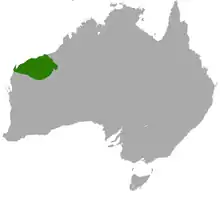Pilbara ningaui
The Pilbara ningaui (Ningaui timealeyi), sometimes known as Ealey's ningaui, is a tiny species of marsupial carnivore found in Australia.
| Pilbara ningaui[1] | |
|---|---|
| Scientific classification | |
| Kingdom: | Animalia |
| Phylum: | Chordata |
| Class: | Mammalia |
| Infraclass: | Marsupialia |
| Order: | Dasyuromorphia |
| Family: | Dasyuridae |
| Genus: | Ningaui |
| Species: | N. timealeyi |
| Binomial name | |
| Ningaui timealeyi | |
 | |
| Pilbara ningaui range | |
Taxonomy
The species was described by Mike Archer in 1975, distinguishing the new taxon from other dasyurids by nominating it as the type species of a new genus. Archer provided a description for a second species of Ningaui, the more widely distributed Ningaui ridei. The holotype is a specimen obtained escaping a fire in spinifex country, a collection made by A. Snell in 1963 at Mount Robinson in the northwest of Australia. Other material examined included a specimen collected in 1957 by E. H. M. Ealey of Monash University, then working as a field officer for the CSIRO, his informal name, 'Tim' Ealey. is the eponym of the specific epithet.[3]
Description
A very small species of marsupial, 45 to 58 millimetres in length. The fur is spiky and dishevelled in appearance, the upperparts are a mix of ginger and brown hairs, or grey-brown, with a rufous coloration across the flanks, ears and face. The eyes are close set and their muzzle is long and pointed. It rarely exceeds 58 mm in body length, with a tail 60 to 76 m long and a weight from 5.0 to 9.4 grams. The female Ningaui timealeyi possess six teats, fewer than others of the genus.[4]
This makes the Pilbara ningaui one of the smallest of all marsupials, surpassed only by the planigales. It is partly arboreal, and differs from other others of the genus in its smaller size and rufous-tinted face.[5]
Distribution and habitat
The species is found in the Pilbara and Gascoyne regions of Western Australia, extending into the Little Sandy Desert. Ningaui timealeyi is recorded as locally common in some locations, such as the Hamersley Range, but is not frequently occur outside of these areas.[4]
Behaviour
A partly arboreal species that forages in the dense undergrowth. Breeding is dependent on the extent of seasonal rain in the region, beginning in September and rearing of young continuing as late as March. The size of each litter may be four to six young.[4]
References
- Groves, C. P. (2005). Wilson, D. E.; Reeder, D. M. (eds.). Mammal Species of the World: A Taxonomic and Geographic Reference (3rd ed.). Baltimore: Johns Hopkins University Press. p. 32. ISBN 0-801-88221-4. OCLC 62265494.
- Burbidge, A. (2008). "Ningaui timealeyi". IUCN Red List of Threatened Species. 2008. Retrieved 28 December 2008.CS1 maint: ref=harv (link)
- Archer, M. (1975). "Ningaui, a new genus of tiny dasyurids (Marsupialia) and two new species, N. timealeyi and N. ridei, from arid Western Australia". Memoirs of the Queensland Museum. 17: 237–249.
- Menkhorst, P.W.; Knight, F. (2011). A field guide to the mammals of Australia (3rd ed.). Melbourne: Oxford University Press. p. 66. ISBN 9780195573954.
- Menkhorst, Peter (2001). A Field Guide to the Mammals of Australia. Oxford University Press. p. 62.
